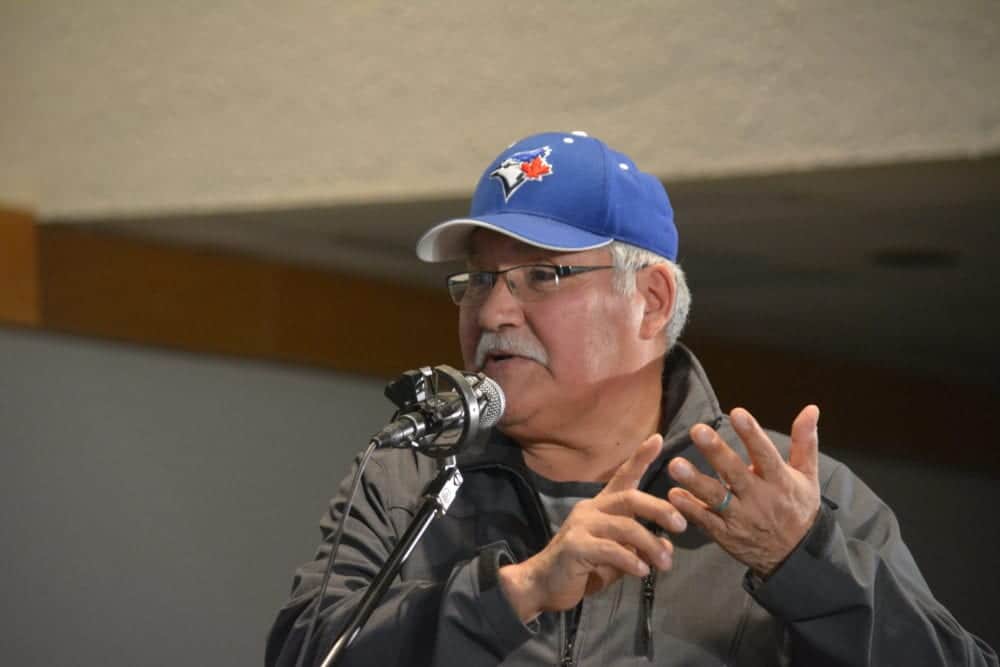How do you decolonize newspapers and multimedia that people interact with daily?
The Dechinta Centre for Research and Learning hosted a panel of Northern media folks in Yellowknife last week to discuss where media gets it wrong and how to serve our audiences better.

Whether today or 50 years ago, stories featuring Indigenous peoples can be pigeonholed, overlooked or stereotypical in nature.
However, Indigenous peoples increasingly have the tools to tell their own stories and need mentorship and on-the-job experience to diversify newsrooms, said Deneze NakehkSA����Ӱ�Ӵ�ý�o.
He is a founding member of Dene Nahjo from Liidlii Kue First Nation and a radio and video journalist, broadcaster and educator.
NakehkSA����Ӱ�Ӵ�ý�o acknowledged the role of Indigenous-centric organizations like CKLB Radio which broadcasts in Dene languages and has trained up several Northern Indigenous journalists, himself included.
SA����Ӱ�Ӵ�ý�Representation is important," he said, adding that having role models in media like former CBC journalists Snookie Catholique and former Tulita chief Paul Andrew was encouraging.
SA����Ӱ�Ӵ�ý�People went out of their way to encourage and support these people with their gifts.TheySA����Ӱ�Ӵ�ý�ve been capable and very good broadcasters and journalists,SA����Ӱ�Ӵ�ý� he said.
Youth mentorship is a pathway to diversifying newsrooms and shifting from stereotypical representations of Indigenous peoples like the four DSA����Ӱ�Ӵ�ý�s: drumming, dancing, drunk or dead said NakehkSA����Ӱ�Ӵ�ý�o.
Those stories, more often told by non-Indigenous reporters are limited portrayals of the spectrum of Indigenous experience and identity, he added.
Building a positive sense of identity for youth starts with mentoring youth early on, said CBC North managing editor Mervin Brass.
Broadcasters like Trails End host Lawrence Nayally take on community outreach and share how they entered the industry.
News media have to SA����Ӱ�Ӵ�ý�start looking in our own backyard,SA����Ӱ�Ӵ�ý� said Nayally, who credits those who took a chance on him to develop as a broadcaster.
Media is itself a colonial construct that has biases embedded within, much like Canadian law and business. But, Indigenous people can start building things made by and for themselves, said NakehkSA����Ӱ�Ӵ�ý�o.
He spoke about CanadalandSA����Ӱ�Ӵ�ý�s Thunder Bay podcast by Ryan McMahon, which unearths the insidious social structures and rampant racism in a Northern Ontario town.
Reporters should ensure they arenSA����Ӱ�Ӵ�ý�t using Indigenous sources in a tokenized position to further a narrative, which often in media, the environmental movement is to SA����Ӱ�Ӵ�ý�check a box,SA����Ӱ�Ӵ�ý� said NakehkSA����Ӱ�Ӵ�ý�o.
"Reconciliation ... if youSA����Ӱ�Ӵ�ý�re feeling uncomfortable, if youSA����Ӱ�Ӵ�ý�re uneasy, then youSA����Ӱ�Ӵ�ý�re reconciling. We live in a time now of courage. Individually we all have the courage to go into those uncomfortable and challenging situations together," he said.
Paul Andrew, a CBC reporter of 30 years and former chief of Tulita told the audience that news articles often frame land claims as settlers "giving" Indigenous people the land they already have a connection with, reinforcing colonial concepts of settler ownership.
"Nobody ever talks about what Indigenous people gave up," he said. SA����Ӱ�Ӵ�ý�It was as if the media bought the argument: SA����Ӱ�Ӵ�ý�WeSA����Ӱ�Ӵ�ý�re doing you such a favour, giving you all of this land.SA����Ӱ�Ӵ�ý� Whereas if you ask people in the land claims groups right now, theySA����Ӱ�Ӵ�ý�re saying SA����Ӱ�Ӵ�ý�How can they give us something we own already?SA����Ӱ�Ӵ�ý�SA����Ӱ�Ӵ�ý�
Stories about caribou that focus heavily on overharvesting, but are devoid of any mention of mining are problematic, said Andrew.
Literacy and access to the news in the North is also a barrier, whether someone doesnSA����Ӱ�Ӵ�ý�t have access to a computer or the internet or English is not their first language, he said.
Made in the North education to train journalists should also be considered with decolonization in mind, he said.
SA����Ӱ�Ӵ�ý�Those are the things we have to challenge in decolonization,SA����Ӱ�Ӵ�ý� said Andrew.
Where did the media get it wrong?
Panelist Laurie Sarkadi, editor of Edge YK pointed to limited media coverage when Indigenous children died of arsenic poisoning after drinking meltwater in 1951.
As Yellowknives Dene reportedly fell ill, government officials held back on informing the public of the dangers posed by arsenic laden meltwater and did not translate information into Weldeh or Dogrib.
Herb Mathisen for UpHere Magazine spoke about a piece the magazine published about a person planning to live exclusively off the land for a year.
Its framing erased the fact that Indigenous peoples have lived off the land since time immemorial and the piece got blowback, he said.
Diversifying a newsroom mandates changing the SA����Ӱ�Ӵ�ý�economic model" and support for the mentorship of Indigenous youth SA����Ӱ�Ӵ�ý� something Yellowknifer editor Michele Taylor initiated in 2017, said Northern News Services publisher Bruce Valpy.
SA����Ӱ�Ӵ�ý�Now that ISA����Ӱ�Ӵ�ý�m in a position to change that model, ISA����Ӱ�Ӵ�ý�m going to do my best,SA����Ӱ�Ӵ�ý� said Valpy.
.png;w=120;h=80;mode=crop)

